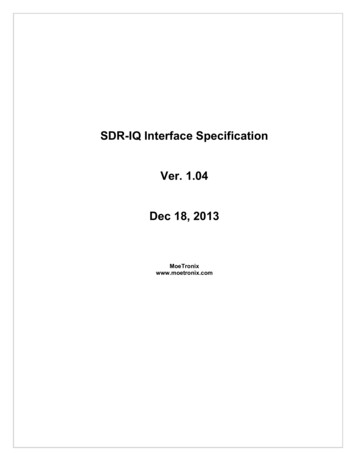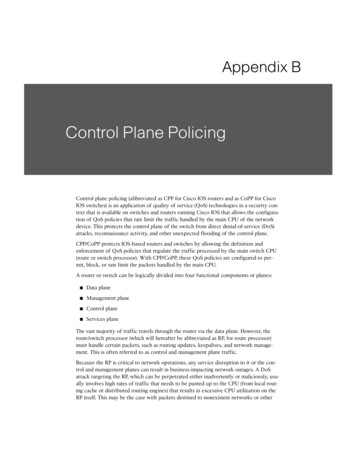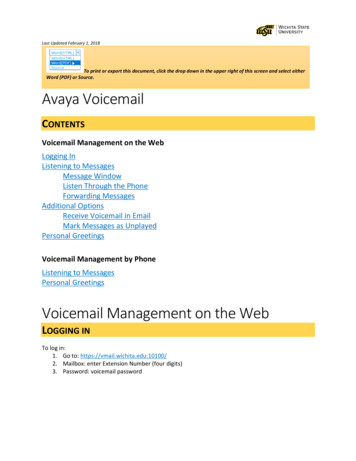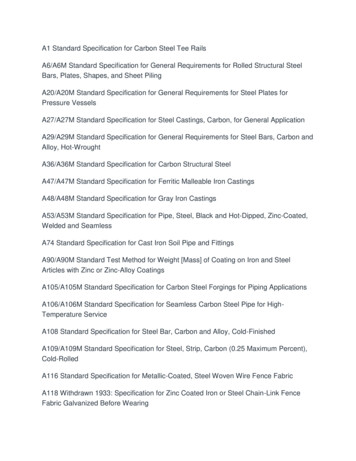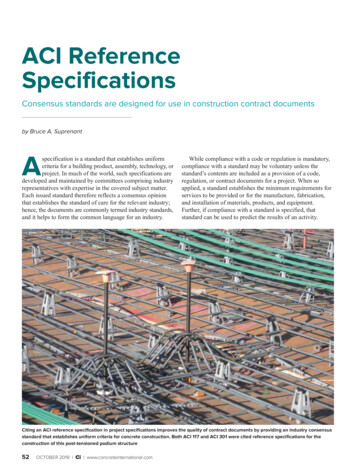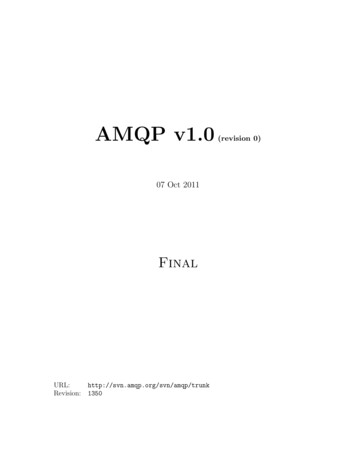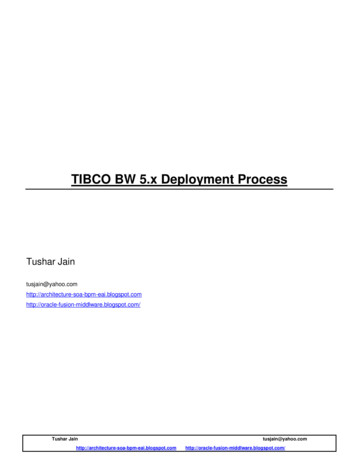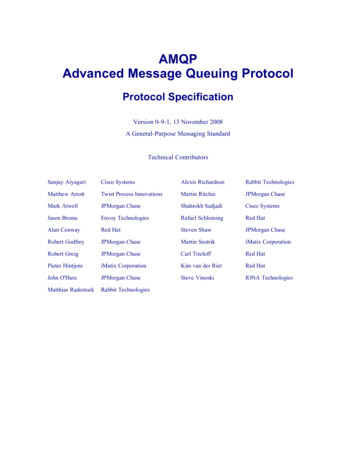
Transcription
AMQPAdvanced Message Queuing ProtocolProtocol SpecificationVersion 0-9-1, 13 November 2008A General-Purpose Messaging StandardTechnical ContributorsSanjay AiyagariCisco SystemsAlexis RichardsonRabbit TechnologiesMatthew ArrottTwist Process InnovationsMartin RitchieJPMorgan ChaseMark AtwellJPMorgan ChaseShahrokh SadjadiCisco SystemsJason BromeEnvoy TechnologiesRafael SchlomingRed HatAlan ConwayRed HatSteven ShawJPMorgan ChaseRobert GodfreyJPMorgan ChaseMartin SustrikiMatix CorporationRobert GreigJPMorgan ChaseCarl TrieloffRed HatPieter HintjensiMatix CorporationKim van der RietRed HatJohn O'HaraJPMorgan ChaseSteve VinoskiIONA TechnologiesMatthias RadestockRabbit Technologies
Copyright (c) 2006-2008. All rights reserved. See Notice and License.Copyright NoticeCopyright 2006-2008 Cisco Systems, Credit Suisse, Deutsche Börse Systems, Envoy Technologies, Inc.,Goldman Sachs, IONA Technologies PLC, iMatix Corporation, JPMorgan Chase Bank Inc. N.A, Novell,Rabbit Technologies Ltd., Red Hat, Inc., TWIST Process Innovations Ltd, WS02, Inc. and 29West Inc. Allrights reserved.LicenseCisco Systems, Credit Suisse, Deutsche Börse Systems, Envoy Technologies, Inc., Goldman Sachs, IONATechnologies PLC, iMatix Corporation, JPMorgan Chase Bank Inc. N.A, Novell, Rabbit TechnologiesLtd., Red Hat, Inc., TWIST Process Innovations Ltd, WS02, Inc. and 29West Inc. (collectively, the"Authors") each hereby grants to you a worldwide, perpetual, royalty-free, nontransferable, nonexclusivelicense to (i) copy, display, distribute and implement the Advanced Messaging Queue Protocol ("AMQP")Specification and (ii) the Licensed Claims that are held by the Authors, all for the purpose of implementingthe Advanced Messaging Queue Protocol Specification. Your license and any rights under this Agreementwill terminate immediately without notice from any Author if you bring any claim, suit, demand, or actionrelated to the Advanced Messaging Queue Protocol Specification against any Author. Upon termination,you shall destroy all copies of the Advanced Messaging Queue Protocol Specification in your possession orcontrol.As used hereunder, "Licensed Claims" means those claims of a patent or patent application, throughout theworld, excluding design patents and design registrations, owned or controlled, or that can be sublicensedwithout fee and in compliance with the requirements of this Agreement, by an Author or its affiliates nowor at any future time and which would necessarily be infringed by implementation of the AdvancedMessaging Queue Protocol Specification. A claim is necessarily infringed hereunder only when it is notpossible to avoid infringing it because there is no plausible non-infringing alternative for implementing therequired portions of the Advanced Messaging Queue Protocol Specification. Notwithstanding theforegoing, Licensed Claims shall not include any claims other than as set forth above even if contained inthe same patent as Licensed Claims; or that read solely on any implementations of any portion of theAdvanced Messaging Queue Protocol Specification that are not required by the Advanced MessagingQueue Protocol Specification, or that, if licensed, would require a payment of royalties by the licensor tounaffiliated third parties. Moreover, Licensed Claims shall not include (i) any enabling technologies thatmay be necessary to make or use any Licensed Product but are not themselves expressly set forth in theAdvanced Messaging Queue Protocol Specification (e.g., semiconductor manufacturing technology,compiler technology, object oriented technology, networking technology, operating system technology, andthe like); or (ii) the implementation of other published standards developed elsewhere and merely referredto in the body of the Advanced Messaging Queue Protocol Specification, or (iii) any Licensed Product andany combinations thereof the purpose or function of which is not required for compliance with theAdvanced Messaging Queue Protocol Specification. For purposes of this definition, the AdvancedMessaging Queue Protocol Specification shall be deemed to include both architectural and interconnectionrequirements essential for interoperability and may also include supporting source code artifacts wheresuch architectural, interconnection requirements and source code artifacts are expressly identified as beingrequired or documentation to achieve compliance with the Advanced Messaging Queue ProtocolSpecification.As used hereunder, "Licensed Products" means only those specific portions of products (hardware, softwareor combinations thereof) that implement and are compliant with all relevant portions of the AdvancedMessaging Queue Protocol Specification.The following disclaimers, which you hereby also acknowledge as to any use you may make of theAdvanced Messaging Queue Protocol Specification:THE ADVANCED MESSAGING QUEUE PROTOCOL SPECIFICATION IS PROVIDED "AS IS,"AND THE AUTHORS MAKE NO REPRESENTATIONS OR WARRANTIES, EXPRESS ORIMPLIED, INCLUDING, BUT NOT LIMITED TO, WARRANTIES OF MERCHANTABILITY,FITNESS FOR A PARTICULAR PURPOSE, NON-INFRINGEMENT, OR TITLE; THAT THECONTENTS OF THE ADVANCED MESSAGING QUEUE PROTOCOL SPECIFICATION AREAdvanced Message Queuing Protocol Specification v0-9-1Page 2 of 39
Copyright (c) 2006-2008. All rights reserved. See Notice and License.SUITABLE FOR ANY PURPOSE; NOR THAT THE IMPLEMENTATION OF THE ADVANCEDMESSAGING QUEUE PROTOCOL SPECIFICATION WILL NOT INFRINGE ANY THIRD PARTYPATENTS, COPYRIGHTS, TRADEMARKS OR OTHER RIGHTS.THE AUTHORS WILL NOT BE LIABLE FOR ANY DIRECT, INDIRECT, SPECIAL, INCIDENTALOR CONSEQUENTIAL DAMAGES ARISING OUT OF OR RELATING TO ANY USE,IMPLEMENTATION OR DISTRIBUTION OF THE ADVANCED MESSAGING QUEUE PROTOCOLSPECIFICATION.The name and trademarks of the Authors may NOT be used in any manner, including advertising orpublicity pertaining to the Advanced Messaging Queue Protocol Specification or its contents withoutspecific, written prior permission. Title to copyright in the Advanced Messaging Queue ProtocolSpecification will at all times remain with the Authors.No other rights are granted by implication, estoppel or otherwise.Upon termination of your license or rights under this Agreement, you shall destroy all copies of theAdvanced Messaging Queue Protocol Specification in your possession or control.Trademarks"JPMorgan", "JPMorgan Chase", "Chase", the JPMorgan Chase logo and the Octagon Symbol aretrademarks of JPMorgan Chase & Co.IMATIX and the iMatix logo are trademarks of iMatix Corporation sprl.IONA, IONA Technologies, and the IONA logos are trademarks of IONA Technologies PLC and/or itssubsidiaries.LINUX is a trademark of Linus Torvalds. RED HAT and JBOSS are registered trademarks of Red Hat,Inc. in the US and other countries.Java, all Java-based trademarks and OpenOffice.org are trademarks of Sun Microsystems, Inc. in theUnited States, other countries, or both.Other company, product, or service names may be trademarks or service marks of others.Advanced Message Queuing Protocol Specification v0-9-1Page 3 of 39
Copyright (c) 2006-2008. All rights reserved. See Notice and License.Table of Contents1 Overview.61.1 Goals of This Document.61.2 Summary.61.2.1 Why AMQP?.61.2.2 Scope of AMQP.61.2.3 The Advanced Message Queuing Model (AMQ model).61.2.4 The Advanced Message Queuing Protocol (AMQP).71.2.5 Scales of Deployment.81.2.6 Functional Scope.81.3 Organisation of This Document.81.4 Conventions.91.4.1 Guidelines for Implementers.91.4.2 Version Numbering.91.4.3 Technical Terminology.92 General Architecture.112.1 AMQ Model Architecture.112.1.1 Main Entities.112.1.2 Message Flow.132.1.3 Exchanges.152.1.4 Message Queues.152.1.5 Bindings.162.2 AMQP Command Architecture.182.2.1 Protocol Commands (Classes & Methods).182.2.2 Mapping AMQP to a middleware API.182.2.3 No Confirmations.192.2.4 The Connection Class.192.2.5 The Channel Class.202.2.6 The Exchange Class.202.2.7 The Queue Class.202.2.8 The Basic Class.212.2.9 The Transaction Class.212.3 AMQP Transport Architecture.222.3.1 General Description.222.3.2 Data Types.222.3.3 Protocol Negotiation.222.3.4 Delimiting Frames.232.3.5 Frame Details.232.3.6 Error Handling.242.3.7 Closing Channels and Connections.242.4 AMQP Client Architecture.253 Functional Specification.263.1 Server Functional Specification.263.1.1 Messages and Content.263.1.2 Virtual Hosts.263.1.3 Exchanges.263.1.4 Message Queues.283.1.5 Bindings.293.1.6 Consumers.293.1.7 Quality of Service.29Advanced Message Queuing Protocol Specification v0-9-1Page 4 of 39
Copyright (c) 2006-2008. All rights reserved. See Notice and License.3.1.8 Acknowledgements.293.1.9 Flow Control.293.1.10 Naming Conventions.293.2 AMQP Command Specification (Classes & Methods).303.2.1 Explanatory Notes.303.2.2 Class and Method Details.304 Technical Specifications.314.1 IANA Assigned Port Number.314.2 AMQP Wire-Level Format.314.2.1 Formal Protocol Grammar.314.2.2 Protocol Header.334.2.3 General Frame Format.334.2.4 Method Payloads.344.2.5 AMQP Data Fields.344.2.6 Content Framing.364.2.7 Heartbeat Frames.374.3 Channel Multiplexing.374.4 Visibility Guarantee.384.5 Channel Closure.384.6 Content Synchronisation.384.7 Content Ordering Guarantees.384.8 Error Handling.384.8.1 Exceptions.384.8.2 Reply Code Format.394.9 Limitations.394.10 Security.394.10.1 Goals and Principles.394.10.2 Denial of Service Attacks.39Advanced Message Queuing Protocol Specification v0-9-1Page 5 of 39
Copyright (c) 2006-2008. All rights reserved. See Notice and License.Overview1 Overview1.1 Goals of This DocumentThis document defines a networking protocol, the Advanced Message Queuing Protocol (AMQP), whichenables conforming client applications to communicate with conforming messaging middleware servers.We address a technical audience with some experience in the domain, and we provide sufficientspecifications and guidelines that a suitably skilled engineer can construct conforming solutions in anymodern programming language or hardware platform.1.2 Summary1.2.1 Why AMQP?AMQP creates full functional interoperability between conforming clients and messaging middlewareservers (also called "brokers").Our goal is to enable the development and industry-wide use of standardised messaging middlewaretechnology that will lower the cost of enterprise and systems integration and provide industrial-gradeintegration services to a broad audience. It is our aim that through AMQP messaging middlewarecapabilities may ultimately be driven into the network itself, and that through the pervasive availability ofmessaging middleware new kinds of useful applications may be developed.1.2.2 Scope of AMQPTo enable complete interoperability for messaging middleware requires that both the networking protocoland the semantics of the server-side services are sufficiently specified. AMQP, therefore, defines both thenetwork protocol and the server-side services through:A defined set of messaging capabilities called the "Advanced Message Queuing ProtocolModel" (AMQ model). The AMQ model consists of a set of components that route and store messageswithin the broker service, plus a set of rules for wiring these components together. A network wire-level protocol, AMQP, that lets client applications talk to the server and interactwith the AMQ model it implements.One can partially imply the semantics of the server from the AMQP protocol specifications but we believethat an explicit description of these semantics helps the understanding of the protocol. 1.2.3 The Advanced Message Queuing Model (AMQ model)We define the server's semantics explicitly, since interoperability demands that these be the same in anygiven server implementation. The AMQ model thus specifies a modular set of components and standardrules for connecting these. There are three main types of component, which are connected into processingchains in the server to create the desired functionality:The "exchange" receives messages from publisher applications and routes these to "message queues",based on arbitrary criteria, usually message properties or content. The "message queue" stores messages until they can be safely processed by a consuming clientapplication (or multiple applications). The "binding" defines the relationship between a message queue and an exchange and provides themessage routing criteria.Using this model we can emulate the classic message-oriented middleware concepts of store-and-forwardqueues and topic subscriptions trivially. We can also expresses less trivial concepts such as content-basedrouting, workload distribution, and on-demand message queues. In very gross terms, an AMQP server is analogous to an email server, with each exchange acting as amessage transfer agent, and each message queue as a mailbox. The bindings define the routing tables inAdvanced Message Queuing Protocol Specification v0-9-1Page 6 of 39
Copyright (c) 2006-2008. All rights reserved. See Notice and License.Overvieweach transfer agent. Publishers send messages to individual transfer agents, which then route the messagesinto mailboxes. Consumers take messages from mailboxes. In many pre-AMQP middleware system, bycontrast, publishers send messages directly to individual mailboxes (in the case of store-and-forwardqueues), or to mailing lists (in the case of topic subscriptions).The difference is that when the rules connecting message queues to exchanges are under control of thearchitect (rather than embedded in code), it becomes possible to do interesting things, such as define a rulethat says, "place a copy of all messages containing such-and-such a header into this message queue".The design of the AMQ model was driven by these main requirements: To support semantics comparable with major messaging products.To provide levels of performance comparable with major messaging products.To permit the server's specific semantics to be programmed by the application, via the protocol.To be flexible and extensible, yet simple.1.2.4 The Advanced Message Queuing Protocol (AMQP)The AMQP protocol is a binary protocol with modern features: it is multi-channel, negotiated,asynchronous, secure, portable, neutral, and efficient. AMQP is usefully split into two layers: ------------------Functional Layer---------------- Basic Transactions Exchanges Message queues -------------------------------------------------- ------------------Transport Layer----------------- Framing Content Data representation Error handling Heart-beatingChannels -------------------------------------------------- The functional layer defines a set of commands (grouped into logical classes of functionality) that do usefulwork on behalf of the application.The transport layer that carries these methods from application to server, and back, and which handleschannel multiplexing, framing, content encoding, heart-beating, data representation, and error handling.One could replace the transport layer with arbitrary transports without changing the application-visiblefunctionality of the protocol. One could also use the same transport layer for different high-level protocols.The design of AMQ model was driven by these requirements:To guarantee interoperability between conforming implementations. To provide explicit control over the quality of service. To be consistent and explicit in naming. To allow complete configuration of server wiring via the protocol. To use a command notation that maps easily into application-level API's. To be clear, so each operation does exactly one thing.The design of AMQP transport layer was driven by these main requirements, in no particular order: To be compact, using a binary encoding that packs and unpacks rapidly.To handle messages of any size without significant limit.To carry multiple channels across a single connection.To be long-lived, with no significant in-built limitations.To allow asynchronous command pipe-lining.Advanced Message Queuing Protocol Specification v0-9-1Page 7 of 39
Copyright (c) 2006-2008. All rights reserved. See Notice and License. OverviewTo be easily extended to handle new and changed needs.To be forward compatible with future versions.To be repairable, using a strong assertion model.To be neutral with respect to programming languages.To fit a code generation process.1.2.5 Scales of DeploymentThe scope of AMQP covers different levels of scale, roughly as follows:Developer/casual use: 1 server, 1 user, 10 message queues, 1 message per second.Production application: 2 servers, 10-100 users, 10-50 message queues, 10 messages per second (36Kmessages/hour). Departmental mission critical application: 4 servers, 100-500 users, 50-100 message queues, 100messages per second (360K/hour). Regional mission critical application: 16 servers, 500-2,000 users, 100-500 message queues and topics,1000 messages per second(3.6M/hour). Global mission critical application: 64 servers, 2K-10K users, 500-1000 message queues and topics,10,000 messages per second(36M/hour). Market data (trading): 200 servers, 5K users, 10K topics, 100K messages per second (360M/hour).As well as volume, the latency of message transfer can be highly important. For instance, market databecomes worthless very rapidly. Implementations may differentiate themselves by providing differingQuality of Service or Manageability Capabilities whilst remaining fully compliant with this specification. 1.2.6 Functional ScopeWe want to support a variety of messaging architectures: Store-and-forward with many writers and one reader.Workload distribution with many writers and many readers.Publish-subscribe with many writers and many readers.Content-based routing with many writers and many readers.Queued file transfer with many writers and many readers.Point-to-point connection between two peers.Market data distribution with many sources and many readers.1.3 Organisation of This DocumentThe document is divided into five chapters, most of which are designed to be read independently accordingto your level of interest:1. "Overview" (this chapter). Read this chapter for an introduction.2. "General Architecture", in which we describe the architecture and overall design of AMQP. Thischapter is intended to help systems architects understand how AMQP works.3. "Functional Specifications", in which we define how applications work with AMQP. This chapterconsists of a readable discussion, followed by a detailed specification of each protocol command,intended as a reference for implementers. Before reading this chapter you should read the GeneralArchitecture.4. "Technical Specifications", in which we define how the AMQP transport layer works. This chapterconsists of a short discussion, followed by a detailed specification of the wire-level constructs, intendedas a reference for implementers. You can read this chapter by itself if you want to understand how thewire-level protocol works (but not what it is used for).Advanced Message Queuing Protocol Specification v0-9-1Page 8 of 39
Copyright (c) 2006-2008. All rights reserved. See Notice and License.Overview1.4 Conventions1.4.1 Guidelines for Implementers We use the terms MUST, MUST NOT, SHOULD, SHOULD NOT, and MAY as defined by IETFRFC 2119.We use the term "the server" when discussing the specific behaviour required of a conforming AMQPserver.We use the term "the client" when discussing the specific behaviour required of a conforming AMQPclient.We use the term "the peer" to mean "the server or the client".All numeric values are decimal unless otherwise indicated.Protocol constants are shown as upper-case names. AMQP implementations SHOULD use these nameswhen defining and using constants in source code and documentation.Property names, method arguments, and frame fields are shown as lower-case names. AMQPimplementations SHOULD use these names consistently in source code and documentation.Strings in AMQP are case-sensitive. For example, “amq.Direct” specifies a different exch
Advanced Message Queuing Protocol Protocol Specification Version 0-9-1, 13 November 2008 . Mark Atwell JPMorgan Chase Shahrokh Sadjadi Cisco Systems . Robert Godfrey JPMorgan Chase Martin Sustrik iMatix Corporation Robert Greig JPMorgan Chase Carl Trieloff Red Hat Pieter Hintjens iMatix Corporation Kim van der Riet Red Hat
![[MS-MQMR]: Message Queuing (MSMQ): Queue Manager Management . - Microsoft](/img/49/5bms-mqmr-5d-160714.jpg)

